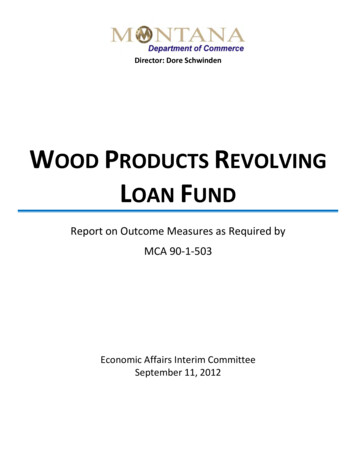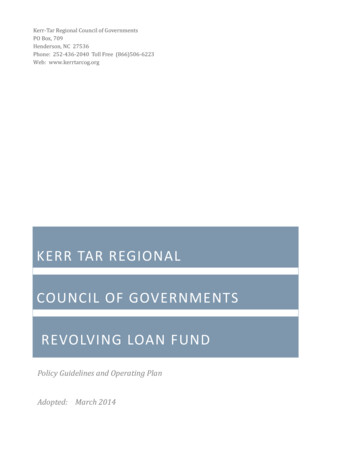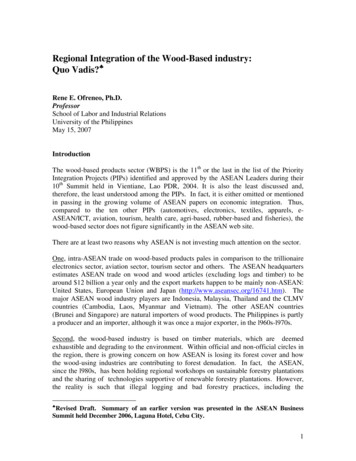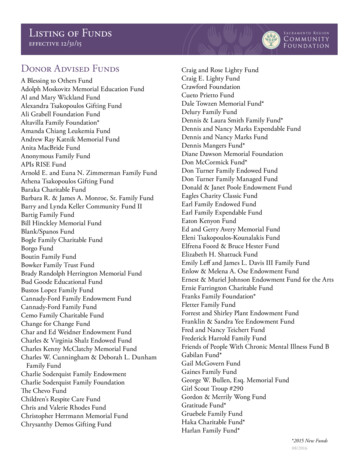
Transcription
Director: Dore SchwindenWOOD PRODUCTS REVOLVINGLOAN FUNDReport on Outcome Measures as Required byMCA 90-1-503Economic Affairs Interim CommitteeSeptember 11, 2012
We make every effort to ensure that our documents are fully accessibleto persons with disabilities. Alternative accessible formats of thisdocument will be provided upon request.For An Alternate FormatPlease contact:Montana Department of Commerce(406) 841-2730 or (406) 841-2702State Relay System 711Carolyn Jones, Section Manager, Commerce Loan FundDebra Demarais, CDBG-ED Section ManagerBusiness Resources DivisionMontana Department of Commerce301 S. Park Ave.P.O. Box 200505Helena, MT 59620-0505http://businessresources.mt.govReport Prepared by:The Census & Economic Information CenterMontana Department of Commercewww.ceic.mt.govii
TABLE OF CONTENTSExecutive Summary .VRecent Economic History of the Montana Wood Products Industry .1Figure 1. Production Workers at all Timber & Wood Residue Processing Facilities & LumberProduction Companies, Montana 2000-2011. 1Legislative Remedy to Address Wood Products Industry Difficulty.2Wood Products RLF Program Capitalization . 2Figure 2. Wood Products RLF Capitalization Sources . 2Wood Products RLF Program Administration . . 3Table 1.Total Wood Products RLF Funding, Total Employees & Number of Companies ThatReceived Loans, June 2009 – March 2010 . 3Table 2.Wood Products RLF – MAEDC Asset Transfers to the MDOC, October 2011. 4Wood Products RLF Outcome Measures . . 4Use of Wood Products RLF Funds – Project Activities. 5Financial Status of the Companies . 5Number of Jobs Created or Retained . 6Table 3.Total Employees & Wages Paid by Skill Level for Companies That Received WoodProducts RLF Funding, Time of Application – June 30, 2012 . 6Pay Level of Employees . 7Table 4.Annual Average Wage by Skill Level for Companies That Received Wood ProductsRLF Funding, Time of Application – June 30, 2012 . 8Employment Impact on Local Production . 9Taxable Value of Property . 10Table 5.Market and Taxable Value of Property Owned by Companies That Received WoodProducts RLF Loans, 2009 & 2012. 10Appendices . . 12Appendix A.Comparison of Wood Products Revolving Loan Fund Sources . 13Appendix B.Location of National Forest Lands in Montana. 14iii
TABLE OF CONTENTS – CONTINUEDAppendix C.Location of Companies That Received Wood Products RLF Loans . 15Appendix D.Wood Products Revolving Loan Fund Account Summary . 16Appendix E.Summary of Smurfit-Stone Creditors’ Accounts Receivables Purchased by MissoulaArea Economic Development Corporation (MAEDC) . 17Appendix F.Summary of Wood Products Revolving Loan Fund Project Totals . 18Appendix G.Wood Products RLF Loan Recipients’ Total Employment, At Time of Application –June 30, 2012 . 19Appendix H.Methodology of Estimation Processes & Definitions . 20iv
Executive SummaryThe 2009 Montana Legislature approved HB669 which created the “Montana Distressed Wood ProductsIndustry Recovery and Stabilization Program” – now referred to as the Wood Products Revolving Loan Fund(Wood Products RLF).Section 1 of HB669 conveys the legislative intent of the bill by stating the following:“Due to the current, well-documented decline in the wood products industry in Montana, thelegislature finds that there is a need to assist the Montana wood products industry as awhole through a revolving loan program.”The passage of HB645 provided the majority of the funding used to capitalize the Wood Products RLF. Thethree sources of funding used to create the revolving loan fund included:Wood Products RLF Capitalization Sources 7.5 million 2.7 million 1.5 million*State General Fund, via HB645 11.7 millionTotal FundingEconomic Development Administration (EDA)Community Development Block Grant - AmericanRecovery and Reinvestment Act (CDBG-R)*Rounded figure. Actual allocated funding equals 1,495,199In June of 2009, the MDOC developed the application guidelines for administering and began implementingthe program. By March of 2010, 99.7% ( 11,265,466) of the original source funding was allocated to 20private companies active in Montana’s wood products industry through loans and 18 wood productscompanies had their Smurfit-Stone outstanding accounts receivables purchased.As required by MCA 90-1-503, the recipient companies are required to submit regular reports on employment,profit/loss summaries, total sales, and assets to the Montana Department of Commerce (MDOC). This reportfulfills the reporting requirements set forth by MCA 90-1-503 through analysis of company employment andconfidential financial records, economic modeling software, and Montana Department of Revenue assessedmarket and taxable value of property records.“we probably wouldn’t be inbusiness today if it were not forthe CDBG [Wood Products RLF]loan”- Smith Logging, Inc.As of June 30, 2012, 17 of the original 20 companies that receivedWood Products RLF loans were still submitting regular employmentand financial reports to the MDOC and were in good standing withtheir loans. The other three companies were no longer participatingin the program 1.1One company was destroyed by a fire and was unable to submit any employment or financial information; one company closed inNovember of 2010; and one company paid its loan in full in May of 2011 releasing them of their reporting obligations to the MDOC.v
Program Successes HighlightsLeverage of Private Funds –The companies that received Wood Products RLF loans wereable to leverage over 21 million from private funding, to the 11.3 million in loans received from the RLF. Including theWood Products RLF funding, more than 33 million was spentin the state due to capital made available by the fund (see page5 of the report - Use of Wood Products RLF Funds).Improved Balance Sheets –“Overall this program has beenextremely beneficial to Sun MountainLumber. It essentially allowed us tocontinue to purchase logs, keep thesawmill running, and make payrollduring the unprecedented housing crisisand recession of the last several years.”- Sun Mountain Lumber, Inc.Before they received any Wood Products RLF loans, 68% of thecompanies were operating at a net loss. Within just 3 monthsof receiving their loan, 84% of the companies improved theirbalance sheet from the quarter before receiving their Wood Products RLF loan (see page 5 of the report Financial Status of the Companies).Increase in Number of Jobs –By June 30, 2012, the 17 private businesses still reporting to the MDOC that received Wood Products RLFloans employed 851 workers in Montana’s wood products industry. This represents a 15.6% (115 jobs)increase over the 736 people employed by all 20 companies before they received the loans (see page 6 ofthe report - Number of Jobs Created or Retained).Increase in Wages Paid –During the same time period, total wages and salaries paid to the employees working for the businessesincreased by over 14% to over 29 million from the 25.7 million at the time the companies applied fortheir loans (see page 6 of the report – Number of Jobs Created or Retained). Average annual wages paidto all employees working for the businesses that received Wood Products RLF loans remained fairlyconstant from the time of original application through June 30, 2012 (see page 7 of the report – Pay Levelsof Employees).Increase in Total Output –Estimated total value added from the output of goods and services produced and provide by the workersemployed by the companies increased by 22% to 161.9 million as of June 30, 2012 from 132.2 million atthe time of application. This represents a substantial increase in the total output injected into the State’seconomy produced and provided by these companies inMontana’s wood products industry (see page 9 of the report –Employment Impact on Local Production).“Pyramid [Mountain Lumber, Inc.]continues to be most appreciative of theState of Montana and the WPIRSprogram. Those loans, with thefavorable terms, have allowed us tooperate and keep our eye on the future.”- Pyramid Mountain Lumber, Inc.Increase in Taxable Value –As of June 30, 2012 the land, improvements, and businessequipment owned by the respective businesses was worthalmost 74.5 million with an estimated taxable value equalto 1.3 million (see page 10 of the report – Taxable Value ofProperty).vi
Recent Economic History of the Montana Wood Products IndustryTimber harvested in Montana from Federal forest lands fell by more than 70% during the 1990’s2; this, alongwith other compounding factors, led to the closing of 15 sawmills in the State between 1990 and 2000 3. Afterlow prices, wildfires, declines in the federal timber offerings, and a spike in electricity rates in 2000, operatingconditions continued to worsen for Montana’s forest products industry through 2001 4.There was a brief recovery in the wood products markets in the second half of 2003 in response to increaseddomestic and global demand. However, 2003 also brought court decisions related to federal lands and yetanother severe wildfire season which constrained the timber harvest which caused log shortages at mills. Thelog shortages prevented Montana mills from taking advantage of the improved market conditions.The collapse of the housing market, the economic recession in late 2008, and dealing with already direoperating conditions pushed the Montana wood products industry to the brink of insolvency in 2008. SomeMontana wood products business owners were no longer drawing salaries and others loaned money to theircompany attempting to keep the business afloat.With companies closingand continued decline intimberharvests,production employment attimber and wood residueprocessing facilities (whichmake up 30 - 40 percent linedsteadily from 2000 through2008withasharpdecrease in 2009 (Figure1).Totallumberproduction followed suitwith a steady decline from2000 through 2009.FIGURE 1.In 2009, Montana’s total wood products industry (including production workers depicted in Figure 1)employed 7,060 5 workers, down about 20% from the 2008 estimated employment of 8,840 6 industry workers.2Appendix B- Location of National Forest Lands in MontanaSpoelma, Timothy P., Morgan, Todd A., Dillon, Thale, Chase, Alfred L., Keegan, III, Charles E. & DeBlander, Larry T. 2008.“Montana’s Forest Products Industry and Timber Harvest”, Resource Bulletin RMRS-RB-8. Fort Collins, CO: U.S. Department ofAgriculture, Forest Service, Rocky Mountain Research Station. 36 p.4Ibid.5Morgan, Todd A., Keegan III, Charles E., Hayes, Steven W. & Sorenson, Colin B. “Montana’s Forest Products Industry: CurrentConditions and 2011 Forecast”. Bureau of Business and Economic Research, University of Montana-Missoula.6Morgan, Todd A. & Keegan III, Charles E. “Montana’s Forest Products Industry: Current Conditions and 2010 Forecast”. Bureau ofBusiness and Economic Research, University of Montana-Missoula.31
To determine whether Montana’s wood products industry could survive the economic challenges it faced, theMontana Department of Commerce (MDOC) funded a study in 2008. That study was conducted by the Bureauof Business and Economic Research, located at the University of Montana-Missoula. The study concluded that: A revolving loan fund could help retain many of the direct jobs employed in the State’s woodproducts industry; andA revolving loan fund might prevent closures and the loss of industry infrastructure - which in turnwould help ensure the sustainable management of Montana’s forests.Legislative Remedy to Address Wood Products Industry DifficultiesThe 2009 Legislature approved the “Montana Distressed Wood Products Industry Recovery and StabilizationProgram” (now referred to as the Wood Products Revolving Loan Fund (Wood Products RLF). The programwas created by passage of HB669 which provided the statutory mechanism to implement the program withfunding via HB645. HB669 passed the House of Representatives with a 43-7 vote, the Senate with a 96-4 vote,and became law in early May 2009. With the passage of HB669 and HB645, the Legislature hoped to assistbusinesses in the wood products and timber industry affected by the recession.In 2008, Montana’s wood products industry employed an estimated 8,840 people 7 who provided the neededexpertise and knowledge essential for sustainable forest management. Partnerships among private and publicland owners facilitate land management practices such as fire hazard reduction, ecosystem restoration, andpost-fire rehabilitation across the State. If the wood products industry were to disappear from the State,these management practices either would not be performed or out-of-state businesses and workers wouldhave to be brought in to do the work with added travel and relocation costs.Wood Products RLF Program CapitalizationTo leverage the 7.5 million allocated by HB645, the MDOC applied for and was awarded a 2.7 million grantfrom the U.S. Department of Commerce, Economic Development Administration (EDA). The MDOC also putalmost 1.5 million 8 of U.S. Department of Housing and Urban Development, Community Development BlockGrant Recovery (CDBG-R) (American Recovery and Reinvestment Act) funds into the Wood Products RLFaccount. For a brief overview of each funding source, see Appendix A.FIGURE 2.Wood Products RLF Capitalization Sources 7.5 million 2.7 million 1.5 million* 11.7 millionState General Fund, via HB645Economic Development Administration (EDA)Community Development Block Grant - AmericanRecovery and Reinvestment Act (CDBG-R)Total Funding* Rounded figure. Actual allocated funding equals 1,495,19978Ibid.Actual figure equals 1,495,199.2
Wood Products RLF Program AdministrationIn June of 2009, the MDOC developed the application guidelines for administering the loans and beganimplementing the program. HB669 states that the MDOC was responsible for developing and reporting onreasonable outcome measures 9 to determine the success of the program. Data on employment, wages paid,and profitability was collected from the companies that received Wood Products RLF funding at the time theyapplied for funding. Companies with outstanding Wood Products RLF loans continue to report similar data tothe MDOC on a regular basis.TABLE 1.Total Wood Products RLF Funding, Total Employees & Number of Companies ThatReceived Loans, June 2009 - March 2010Total RLF Lending Total EmployeesOriginal Funds Available 11,295,199Month of FundingJune 2009*July 2009August 2009September 2009October 2009November 2009December 2009January 2010February 2010**March 2010Total Balance of Original Funds 29,734---# of --* Represents funds distributed to the Missoula Area Economic Development Corporation (MAEDC)for purchase of Smurfit-Stone creditors' accounts receivables and to cover the administrative costsincurred while doing so.** Two companies received funding in February 2010, but one company previously receivedadditional funding in August 2009. That company's employment figures are represented in theAugust 2009 total.From June of 2009 through March of 2010, 99.7% of the original Wood Products RLF source funding wasloaned to 15 private Montana companies and one economic development organization (Table 1). Aneconomic development organization, the Missoula Area Economic Development Corporation (MAEDC),purchased accounts receivables from 18 companies from the Smurfit-Stone bankruptcy 10 and approved loansto an additional five companies. In total, 11.3 million was allocated to 20 private companies in the woodproducts industry through loans and 18 wood products companies had their Smurfit-Stone outstanding9Some of the performance measures included in the bill are the number of jobs retained or created, pay levels, growth of the localeconomy, and the financial status of the companies.10The purchase of the accounts receivables from Smurfit-Stone creditors was a one-time payment with no additional reportingrequired; these transactions were not tied to continued employment standards.3
accounts receivables purchased. Four of the companies that had their accounts receivables purchased alsoreceived Wood Products RLF loans (included in the 20 companies).Most of the Wood Products RLF loans were made with favorable terms for permanent working capital andequipment. Most of the principal and interest payments on the loans were deferred enabling the companiesto remain in business without draining cash reserves from operations. Due to the payment deferment, mostof the principal payments to the Wood Products RLF did not begin until the fall of 2011. Now that principalpayments have started coming into the MDOC, the Wood Products RLF has started to re-capitalize. Thiscreates revolved funds available to make new loans to Montana’s wood products companies.In February of 2012, the MDOC loaned an additional 145,000 to a company that had previously received oneof the original 20 Wood Products RLF loans. Using original and revolved funds, as of June 30, 2012, theMDOC has loaned over 11.4 million to 20 private businesses operating in Montana’s wood productsindustry (See Appendix D for a complete summary of the Wood Products RLF account).In July 2011, the Board of Directors for the Missoula Area Economic Development Corporation (MAEDC) votedto disband the organization. The assets held by MAEDC in their Wood Products Loan portfolio weretransferred to the MDOC for continued administration. This asset transfer was finalized in October of 2011and is detailed in Table 2 below.TABLE 2.Wood Products RLF - MAEDC Asset Transfers to the MDOC, October 2011MAEDC AssetsRevolving Loan Fund Cash BalanceLoans OutstandingLien on Stimpson Lumber CompanyTotal of AssetsFunding 316,916 418,670 179,799 915,385Wood Products RLF Outcome MeasuresThere were 20 private Montana businesses operating in the wood products industry that received WoodProducts RLF loans (from either the MDOC or the MAEDC) between June of 2009 and March of 2010. Toassess the progress and measure the success of the Wood Products RLF program, the loan recipientcompanies are required to submit regular reports on employment, profit/loss summaries, total sales, andassets.No financial or employment obligations were set for the purchasing of Smurfit-Stone accounts receivables sothose recipients were not required to report any financial statements to the MAEDC or the MDOC. Therefore,the companies that did not also receive a Wood Products RLF loan (in all 14 companies) are not included in theanalysis in this report. For a summary of the Smurfit-Stone accounts receivables purchased by MAEDC, seeAppendix E.In February of 2010, Wedge Wood Products, LLC, located in Lincoln County, lost everything to a structural firewhere their offices and operations were located. The company has still committed to paying back its Wood4
Products RLF loan to the MDOC; but, due to that fire, Wedge Wood Products, LLC could not supply the MDOCwith any accounting statements. The analysis that follows omits Wedge Wood Products, LLC financial figures.Use of Wood Products RLF Funds – Project ActivitiesMCA 90-1-503By March of 2010, 99.7% of the original Wood Products RLF available funding was expended on loans to 20private businesses operating in Montana’s wood products industry and the purchase of Smurfit-Stoneaccounts receivable held by 18 companies.Based on the information and data provided by the Wood Products RLF recipients, the use of loan funds thatprovided the best overall results was for working capital. By providing businesses with long term loans at alow interest rate and deferred payments, most companies have been able to continue covering currentoperating expenses. At the same time, this allowed the companies to preserve cash instead of using it for loanpayments.Legislation required that the funds from the state-funded Wood Products RLF be used for: Purchase or lease of land or equipment;Update of infrastructure, including retrofitting old infrastructure to facilitate new uses;Working capital;Debt service;Matching funds for grants or other loans that comply with the intent of the Wood Products RLF fundingprogram; orAny other use the MDOC determines would sustain and grow the wood products industry.The companies that received Wood Products RLF loans were able to leverage the 11.3 million in loans to 21million (for a summary of project totals see Appendix F). Including the Wood Products RLF funding, more than 33 million was spent in the State due to the capital made available by the fund. Funds from the EDA andCDBG-R Wood Products RLFs were primarily used for working capital and equipment loans and other activitiesthat do not include contracted labor or construction.Financial Status of the Companies 11MCA 90-1-503To assess the financial status of the companies that received Wood Products RLF loans, confidential financialstatements submitted to the MDOC by the respective companies were analyzed.Before they received Wood Products RLF loans – 68% (13 of 19) of the companies were operating at a netloss.As of June 30, 2010 – of the 20 companies that received Wood Products RLF loans, 19 were still in operation.The remaining company, Wedge Wood Products, LLC, was completely destroyed by a fire. At the time ofwriting this report, Wedge Wood Products has not dissolved as an LLC but is awaiting the ruling on a lawsuit. 11For the quarter (3-month period) immediately following that in which the loan was received by thecompanies, over half (53% or 10 companies) of the companies were operating in the black.See Appendix H for methodology of financial status analysis.5
Within just 3 months of receiving their Wood Products RLF loan, 84% (16 companies) improved theirbalance sheet from the quarter before receiving their loan. Of these companies, three realized acomplete turnaround, from a loss to a profit of nearly the same absolute amount.As of June 30, 2011 12 – of the 20 original companies that received Wood Products RLF loans, 17 of them wereknown to still be in operation and in good standing with the MDOC on their Wood Products RLF loans. JubileeTransport, LLC paid off its loan in full in May 2011 which released them from their financial and employmentreporting obligations to the MDOC. Neville Log Homes, Inc. shut down operations in November of 2010. Of the 17 companies, nine (53%) of them were operating at an average net profit for the calendar yearof 2011.Almost 60% (10 companies) of the companies increased their average quarterly bottom line from thatof calendar year 2010.Seven (41%) of the companies saw an increase in their average quarterly sales for calendar year 2011over that of 2010. Six of the ten companies that did not see an increase in their average quarterly salesrealized a decrease of less than 5% from calendar year 2010 to 2011.As of June 30, 2012 – the MDOC had received financial statements for the first quarter (January – March) of2012 from two companies. Because financial reporting requirements after the first 2 years switch fromquarterly to annual, more current financial reports were not available at the time of writing this report. Both of the companies that had submitted their profit/loss statements to the MDOC reported a netprofit in the first quarter of 2012 well above their respective 2011 average quarterly profit/loss figures.One of these companies had been operating at a net loss during the entire calendar year of 2011.Number of Jobs Created or Retained (Table 3)MCA 90-1-503TABLE 3.Total Employees & Wages Paid by Skill Level for Companies That Received Wood Products RLF Funding,Time of Application - June 30, 2012At Time Of Application[1]Skill LevelEmployeesTotal WagesPaidAs of June 30, 2010 [2]EmployeesTotal WagesPaidAs of June 30, 2011 [3]EmployeesTotal WagesPaidAs of June 30, 2012 [4]EmployeesTotal WagesPaidManagers/Prof.104 5,618,93199 5,408,14293 5,545,20699 5,791,757Skilled225 8,265,444225 8,000,957238 8,663,568279 9,763,999Semi-skilled262 7,776,933238 7,373,890306 8,999,661266 7,988,716Unskilled94 2,451,807151 3,919,329172 4,648,224174 4,762,743Office & Clerical51 1,635,06188 2,382,91952 1,806,54633 1,051,098736 25,748,176801 27,085,237861 29,663,205851 29,358,313TOTALFigures may not sum due to rounding.[1] Figures reflect data from 19 companies. Wedge Wood Products, LLC was destroyed in a fire and was unable to submit anyemployment information to the MDOC.[2] Figures reflect data from 19 companies. See footnote [1] for explanation.[3] Figures reflect data from 17 companies; Neville Log Homes, Inc. closed in November 2010 and Jubilee Transport, LLC paid its loanin full in May 2011.[4] Figures reflect data from 17 companies; see footnote [3] for explanation.12In order to maintain consistency with time intervals throughout this report, “June 30” is used as a benchmark date. However,confidential financial records from the participating companies for all of calendar year 2011 are used to assess “2011 averagequarterly profit/loss and sales” figures.6
At the time of application – the 19 private businesses (see Table 3 footnote [1]) that received Wood ProductsRLF loans employed a total of 736 workers who received over 25.7 million in wages and salaries. Thistranslates to an estimated 1.4 million 13 contributed to the State through individual income taxes.At the time the MAEDC purchased Smurfit-Stone accounts receivables from 18 businesses (4 of which alsoreceived a Wood Products RLF loan), the 14 business that did not also receive a loan employed 84 workers inthe State. No salary or wage information is required of these companies and, therefore, is not included in theanalysis of this report.As of June 30, 2010 – the 19 private businesses (see Table 3 footnote [2]) employed a total of 801 workerswho received over 27 million in labor compensation. This represents an 8.8% (65 jobs) increase inemployment and a 5.2% (more than 1.3 million) increase in total wages and salaries paid out (not adjustedfor inflation) from the time of application. The estimated contribution to the State by way of state incometaxes paid by these workers was nearly 1.5 million.As of June 30, 2011 – the 17 private businesses (see Table 3 footnote [3]) continued to increase totalemployment (7.5% or 60 jobs) and annual payroll (9.5% or almost 2.6 million) from the previous year to 861workers and more than 29.6 million, respectively. This is a 17% (125 jobs) increase in total employment anda 15.2% (more than 3.9 million) increase in wages and salaries paid since the time of application in 2009. Thecontribution to the State through individual income taxes also increased to an estimated 1.6 million.As of June 30, 2012 – the 17 private businesses that received Wood Products RLF loans (see Table 3 footnote[4]) reported employing 851 workers who were paid almost 29.4 million in wages and salaries during theperiod. The State received an estimated 14 1.59 million in individual income taxes paid on the wages andsalaries received by the employees of the respective businesses.Pay Levels of Employees (Table 4)MCA 90-1-503As with all industries, companies in the wood products industry require workers with varying levels of skill andability. Using employment reports provided to the MDOC by the companies that received Wood Products RLFloans, workers are categorized into “skill” groups for reporting and analysis purposes. The skill groups are:1.2.3.4.5.Managers, Professionals & Technicians;Skilled;Semi-skilled;Unskilled; andOffice & Clerical.The owners and/or managers of the companies and highly professional or technical positions make up theManagers, Professionals & Technicians group. Skilled workers include sales representatives, mechanics,millwrights, electr
The 2009 Legislature approved the Montana " Distressed Wood Products Industry Recovery Stabilization and Program" (now referred to as the Wood Products Revolving Loan FundWood Products (RLF). The program was created by passage of HB669 which provided the statutory mechanism to implement the program with funding via HB645.










